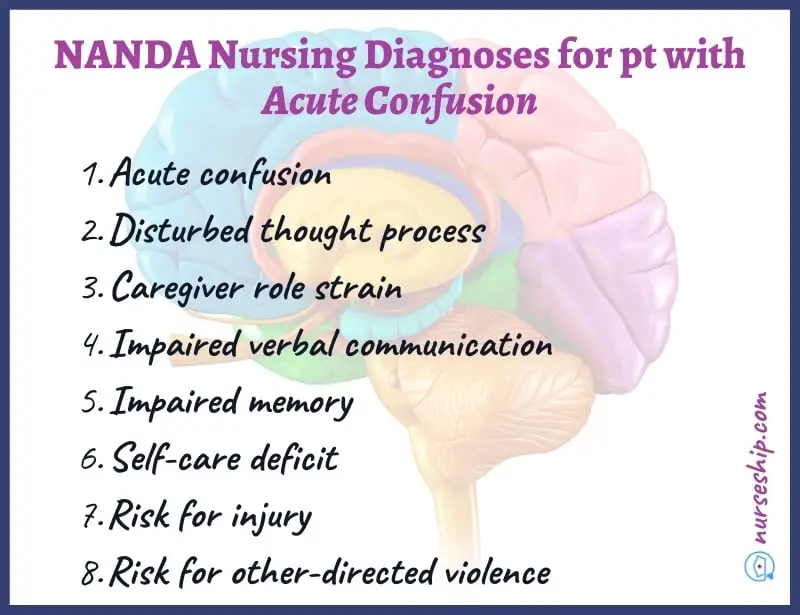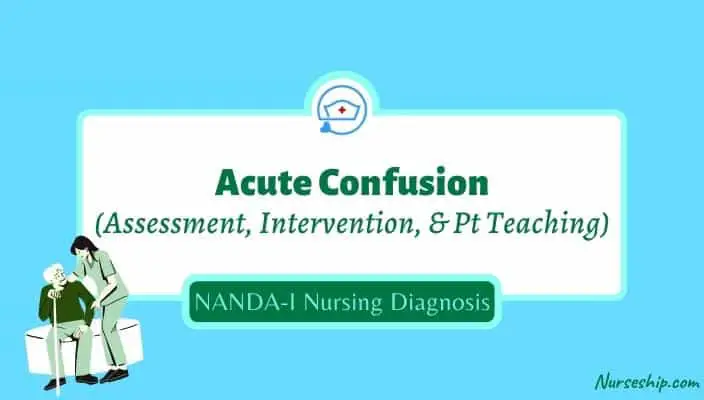Last updated on December 28th, 2023
In this post, you will find NANDA-I nursing diagnosis for Acute confusion. These include actual and risk nursing diagnoses.
Acute confusion nursing assessment and interventions, and patient teaching are all included.
8 NANDA-I nursing diagnoses for acute confusion
- Acute confusion
- Disturbed thought process
- Caregiver role strain
- Impaired verbal communication
- Impaired memory
- Self-care deficit
- Risk for injury
- Risk for other-directed violence
Actual nursing diagnosis for acute confusion
#1 Acute confusion
| May be related to | As evidenced by |
| Old age, alcohol intoxication, trauma/head injury, sleep deprivation, hypoxemia, metabolic discrepancies such as hyponatremia, vitamin deficiencies, endocrine problems such as hypo/hyperthyroidism | Lack of orientation, rambling speech, distractibility, agitation, misperceptions, variations in the sleep-wake cycle, restlessness, decline in psychomotor activity |
#2 Disturbed thought process
| May be related to | As evidenced by |
| Cognitive impairment secondary to acute confusion | Problems with coordination, disorientation to time place, and person, inactivity to perform activities of daily living |
#3 Caregiver role strain
| May be related to | As evidenced by |
| Complete dependence, extent of caregiving required | Social withdrawal, irritability, insomnia, loss of interest in hobbies, crying easily |
#4 Impaired verbal communication
| May be related to | As evidenced by |
| Cognitive impairment, altered perceptions | Inability to interpret internal or external stimuli, difficulty establishing verbal communication, thought blocks |
# 5 Impaired memory
| May be related to | As evidenced by |
| Cognitive impairment secondary to confusion | Inability to follow commands, impulsive acting, disorientation to time, place and person, decreased reasoning ability, easy distractibility, unkempt appearance |
#6 Self-care deficit
| May be related to | As evidenced by |
| Cognitive impairment | Inability to perform self-care activities, foul body odor, unkempt appearance |
Risk NANDA-I nursing diagnosis for acute confusion
#1 Risk for injury
Associated risk factors
- confusion
- Suicidal ideation
- Hallucinations
- Illusions
#2 Risk for other-directed violence
Associated risk factors
- Suspiciousness of others
- Misinterpretation of actions/ words

Nursing priorities for acute confusion
- Safety measures
- Orientation to surrounding
- Treatment of underlying conditions
Nursing management for acute confusion
Nursing Assessment
- Identify contributing factors such as substance abuse, presence of acute infection, exposure to toxic substances, seizure history, episodes of fever/pain
- Mental status assessment
- Assess the patient’s behavior over the period of admission
- Assess for the presence/absence of a support system.
- Assess the extent of impairment
- Asses for preferred means of communication either written, oral or gestures, and capacity to comprehend
- Take vital signs
- Monitor lab values
Nursing Interventions
- Orientation of patients to surrounding, ward staff, and day-to-day schedule at the hospital.
- Implement safety measures
- Treat underlying problems such as intoxication, hypoxia, pain, biochemical imbalance, infections, and/or nutritional deficit.
- Ensure the patient is a calm surrounding always by modulating sensory exposure.
- Reduce the overuse of drugs with a similar mode of action, or interactions between medications to prevent interference with cognition.
- Maintain a routine that covers the whole day, with an aim to maximize exposure to sunlight and prevent daytime naps.
- Involve the patient’s family in management
- Ensure continuity of care after discharge (discuss with case management)
- Ensure patient is accompanied at all times
- Establish realistic health goals and expectations with family
- Health education on causes and symptoms to prevent recurrences.
Patient teaching for acute confusion
- Teach the family to recognize signs of impending confusion
- Reassure the patient and their family
- Teach the family to help the patient establish and maintain a daily routine at home.
- Educate family on safety measures at home
Conclusion
To sum up, you now know eight NANDA-I nursing diagnoses for acute confusion that you can use in your nursing care plans.
Additionally, you have also learned about nursing assessment, nursing interventions, and patient teaching for acute confusion.
Reference
Ackley, B., Ladwig, G., Makic, M., Martinez-Kratz, M., & Zanotti, M. (2020). Nursing Diagnoses Handbook: An Evidence-based Guide to Planning Care (12th ed.). Elsevier.
Gulanick, M., & Myers, J. L. (2022). Nursing care plans: Diagnoses, interventions, and outcomes. Elsevier Health Sciences.
Herdman, T., Kamitsuru, S. & Lopes, C. (2021). NURSING DIAGNOSES: Definitions and Classifications 2021-2023 (12th ed.). Thieme.


